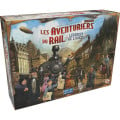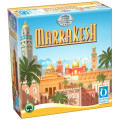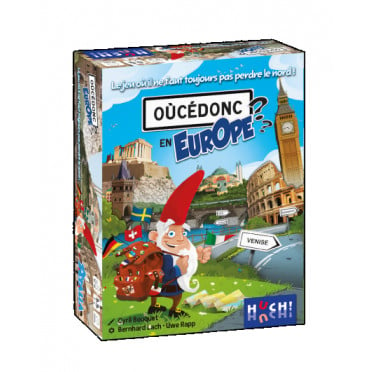OùCéDonc en Europe
OCDEU
- French
- From 10 years old
- less than 30mn
- 2 to 6 player(s)
The game where you must not lose the North!
Where can Samara be located? East or west of Amsterdam?And Etna, north or south?
If you are familiar with the map of Europe, you will have no trouble placing the locations in relation to each other. If not, this is a fun way to discover Europe!
How the game works
In Oucedonc, you will have to sort the Location cards according to their geographical position, on a north-south or east-west axis. Players earn tokens by making the fewest mistakes and by detecting the mistakes made by their opponents.How the game unfolds
A card is drawn and placed in the center of the table, this is the starting card. On his turn, the player draws a card and places it along the north-south or east-west axis that passes through the starting card.
Note: at the beginning of the game, the player has only four possibilities: above the starting card (north), below (south), left (west) or right (east).
The next player in turn draws a card from the pile and decides whether to place it on top, underneath, to the left or right, or between two cards already placed.
Players' opinions
If all players think that the card played is correctly placed, then it is the next player's turn. However, if one of the players thinks that the new Place card is incorrectly placed (too far west or too far east on the east-west axis, too far north or too far south on the north-south axis), he/she turns over the card that has just been placed as well as a card of his/her choice next to it.Checking the position
The coordinates of the card that has just been placed are then compared with those of the neighboring card chosen. The others are not taken into account. On the back of each card are the coordinates (longitude and latitude) of the location. If a player has reason to doubt the position of the card, he receives a token from the player who placed the card. The card is then removed from the game.If a player was wrong to doubt the position of the card, he gives the player who placed it one of his tokens. The card remains in play. Both cards are turned over so that only the names of the places are visible again.
How do you win?
Intermediate countdown
Players take turns playing until the first "Intermission" card appears, triggering an interim countdown.All players must then estimate how many cards in play are misplaced. Each player writes down their estimate on a sheet of paper. The cards in play are then turned over and checked. Important: The check always starts from the starting card by comparing its coordinates with those of the immediate neighboring cards. The players check, one by one, the position of each card. Any card that is incorrectly placed with the card in front of it is discarded. All the cards thus discarded are counted.
The player who has found the right number wins 2 tokens from the reserve. In case of a tie, all players win 2 tokens. If no player has found the correct number, the player who comes closest wins 1 token.
All cards in play, including the start card, are removed from the game. A new starting card is drawn from the pile of cards left over from the preparation. The game resumes with the player whose turn it was.
End of the game
When all 3 packs of 15 cards are used up, a final countdown takes place and the game ends. The winner is the player with the most chips.This game appears in the Tops Games of our players
-
Tous nos jeux
par Bilouwanadoofr
-
Jeux de Atalia Jeux
par Les Ch’tis Ludiques
View all Tops Games
Copyright © 2025 www.philibertnet.com Legals - Privacy Policy - Cookie Preferences - Sitemap






